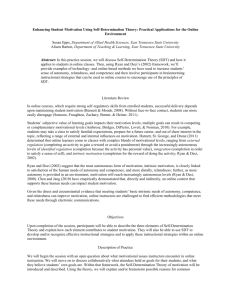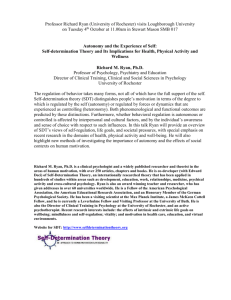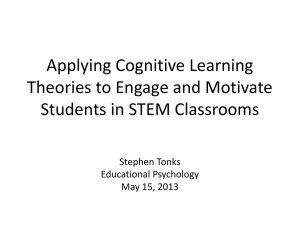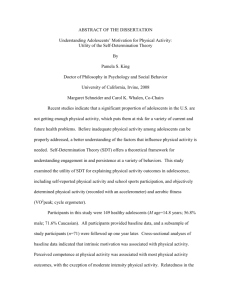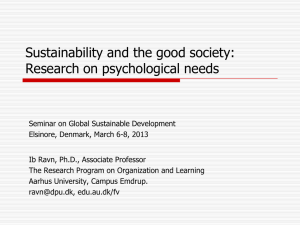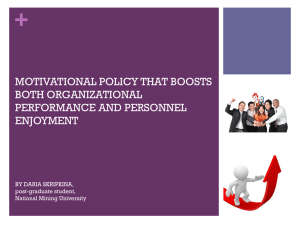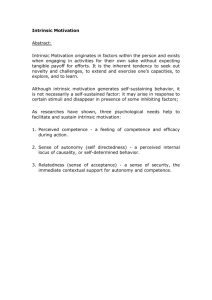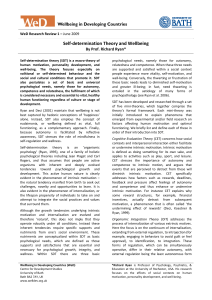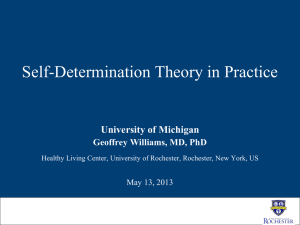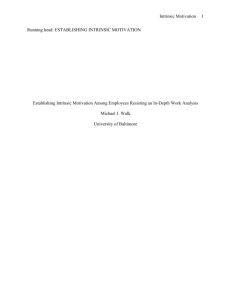Ten_Cate_SDT_25_May_2011
advertisement
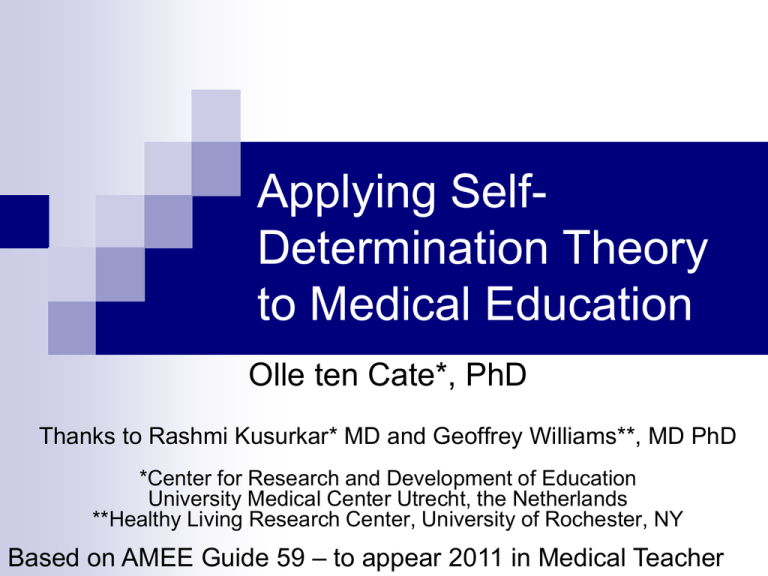
Applying SelfDetermination Theory to Medical Education Olle ten Cate*, PhD Thanks to Rashmi Kusurkar* MD and Geoffrey Williams**, MD PhD *Center for Research and Development of Education University Medical Center Utrecht, the Netherlands **Healthy Living Research Center, University of Rochester, NY Based on AMEE Guide 59 – to appear 2011 in Medical Teacher Self-Determination Theory (SDT) A theory of human motivation What drives people to do what they do? How can we use insights of SDT to understand processes in medical education? Evidence is still limited SDT a lens through which to view medical education Overview Founders of Self Determination Theory Seven principles that ground SDT The three psychological needs The spectrum of motivation types Selected examples to view elements of medical education through the lens of SDT Founders of SDT: Edward Deci & Richard Ryan – U of Rochester NY Seven principles 1. Man is growth-oriented, wants to build a ‘unified sense of the self’ and integrate in social structures. This tendency can be stimulated or hampered. 2. Three innate psychological needs determine this ongoing growth: need for competence, need for autonomy and need for relatedness 3. Behavior is regulated differently for different modes of motivation (Amotivation, Extrinsic motivation, Intrinsic motivation) with different loci of causality Spectrum of motivation according to SDT Seven principles 4. Externally regulated behavior can become internally regulated 5. Stable intrinsic motivation requires the ongoing satisfaction of the three psychological needs 6. High intrinsic motivation and autonomous selfregulation is associated with high levels of learning, understanding, performance, well-being 7. Extrinsic behavior regulation has shades: external, introjected, identified and integrated; combined in a dichtomy: controlled self-regulation and autonomous self-regulation Spectrum of motivation according to SDT Three needs associated with intrinsic motivation when satisfied 1. COMPETENCE People like doing what they are good at; this motivates to get going Three needs associated with intrinsic motivation when satisfied 2. AUTONOMY People better like doing things if they can determine it on their own from a position of free choice Three needs associated with intrinsic motivation when satisfied 3. RELATEDNESS People like to belong to a group that matters and to feel accepted by its members Internalizing extrinsic motivation 1. Abiding by a law or rule, only to avoid punishment (external regulation) 2. Accepting rules and regulations of others, even when rationally disagreeing (introjection) 3. Sincere understanding, agreeing with and fully accepting rules of others (identification) 4. Fully integrating rules and regulations of others with own norms and values, because of conviction (integration) Some general findings Use of extrinsic rewards (e.g. money, punishment) deminishes intrinsic motivation. Reasons for action shift. Some general findings Autonomously motivated learners thrive and students benefit academically when teachers support autonomy Some general findings SDT based approaches in patient care have been effective with alcohol treatment programmes weight loss programmes adherence to medication programmes smoking cessation programmes Selected applications of SDT to medical education Curriculum effects in highly motivated students Selection effects for medical school Assessment and examinations Effects of clinical responsibilities Subtleties in feedback wording Offering electives in the curriculum Students as teachers and researchers Teacher motivation and curriculum models The power of being determined to become a doctor Within SDT, the Organismic Integration mini Theory (OIT) predicts that the three need satisfaction forces will make individuals overcome hurdles to become selfdetermined. External influences (parents, teachers, employers etc) can stimulate or hamper. The power of being determined to become a doctor Most medical students are highly motivated. High motivation makes them want to adapt to whatever circumstances require whatever study effort is asked Greatly different curricula, may yield just as competent doctors Much of the variance of outcomes of education may be determined by this motivational power. Speculating.. teaching methods assessment system talent motivation residual Selection for medical school Passing a selection hurdle may give candidates: - Feeling of competence (“I’m really good!”) - Feeling of relatedness (“now I belong to this group”) While psychometrically selection procedures may be weak and disputable, they may be great at generating motivation Examinations Collective assessment typically does not stimulate autonomy Stimulating students to take exams when they feel ready may create feelings of autonomy Computer-based testing may create such possibilities Feedback wording makes a difference Shifting from the individual to the context, to manipulate feeling competent: “you are failing” versus “this case is hard to master” Shifting from instruction to self-regulation, to support autonomy: “let me tell you what to do” versus “tell me how you think you want to do this, and ask me anything you want” Pulling students into the professional community, to stimulate feeling related: “you do not understand how we do this” versus “we all struggled to master this, you’ll get there too” Electives Electives create student autonomy In-depth study in a selected field may create feelings of competence in comparison with others Clinical responsibilities If students in clerkships are allowed to legitimately participate in health care, be it even peripherally (Lave & Wenger) … …their feelings of competence, autonomy and relatedness may be boosted … supporting intrinsic motivation Being formally acknowledged to carry out an EPA, even a small one, may generate this Students as teachers, researchers Senior students can successfully execute teacher tasks. Being a near-peer teacher for junior students can generate feelings of competence and autonomy and probably relatedness Students publishing in scientific journals* feel competent and become part of the community *15% of Dutch med stds publish >1 paper before graduation – Van Eyk et al 2010 Teacher motivation Highly integrated, centrally managed and coordinated, problem-based curricula risk a decrease of teacher motivation: - Less autonomy to determine content and method - Less possibility to apply personal expertise In conclusion Self-Determination Theory offers a different lens through which to observe medical education Effects of autonomy-supportive teaching curriculum structure have not been well studied in higher education and medical education but seem promising Selected references 1. 2. 3. 4. 5. 6. 7. Deci EL. 1971. Effects of externally mediated rewards on intrinsic motivation. J Pers Soc Psychol 18105-1151971 Deci EL, Ryan RM. 2000. The “What” and “Why” of goal pursuits: human needs and the self-determination of behavior. Psychological Inquiry 11(4) 227-268. Deci EL, Ryan RM. (Eds) 2002. Handbook of Self-Determination Research. University of Rochester Press Rochester NY 2002 Kusurkar RA, Ten Cate ThJ, Van Asperen MA, Croiset G.Motivation as a dependent and independent variable in medical education: a review of the literature. Medical Teacher 33(5): e242-e262. Reeve J. 2002. Self-determination theory applied to educational settings. In: Deci E.L. Ryan R.M. (Eds) Handbook of Self-Determination Research. University of Rochester Press Rochester NY, pp. 183-203. Ryan RM, Deci EL. 2000. Self-determination Theory and the facilitations of intrinsic motivation social development and well-being. Amer Psych 55 (1) 68-78. Ten Cate OThJ, Kusurkar RA, Williams GC. How can Self-Determination Theory assist our understanding of the teaching and learning processes in medical education? AMEE guide 59. Medical Teacher (in press) References, continued: 9. 10. 11. 12. 13. 14. 15. Ten Cate O, Durning S. Dimensions and psychology of peer teaching in medical education. Medical Teacher 2007;29(6):546-552 Van den Berg BAM, Ten Cate ThJ, Ritzen MMJ. Needs assessment among teachers at UMC Utrecht. Report within the Strategic Plan of Education 2010-2015 at UMC Utrecht. April 2011. [unpublished, Dutch] Van Eyk et al. Scientific output of Dutch medical students. Med Teach 2010; 2010; 32: 231–235 Williams GC, Wiener MW, Markis KM, Reeve J, Deci EL. 1994. Medical students’ motivation for Internal Medicine. J. Gen Int Med 9:327-333 Williams GC, Deci EL. 1996. Internalization of biopsychosocial values by medical students: A test of self-determination theory. J Pers Soc Psych70 767-79. Williams G, Saizow RB, Ryan RM. 1999. The importance of SelfDetermination Theory for Medical Education Acad Med 74 992-995. Williams GC, McGregor H, Sharp D, Kouides R, Levesque C, Ryan RM, et al. 2006. Testing a Self-Determination Theory Intervention for Motivating Tobacco Cessation: Supporting Autonomy and Competence in a Clinical Trial. Health Psych 25(1) 91-101.
